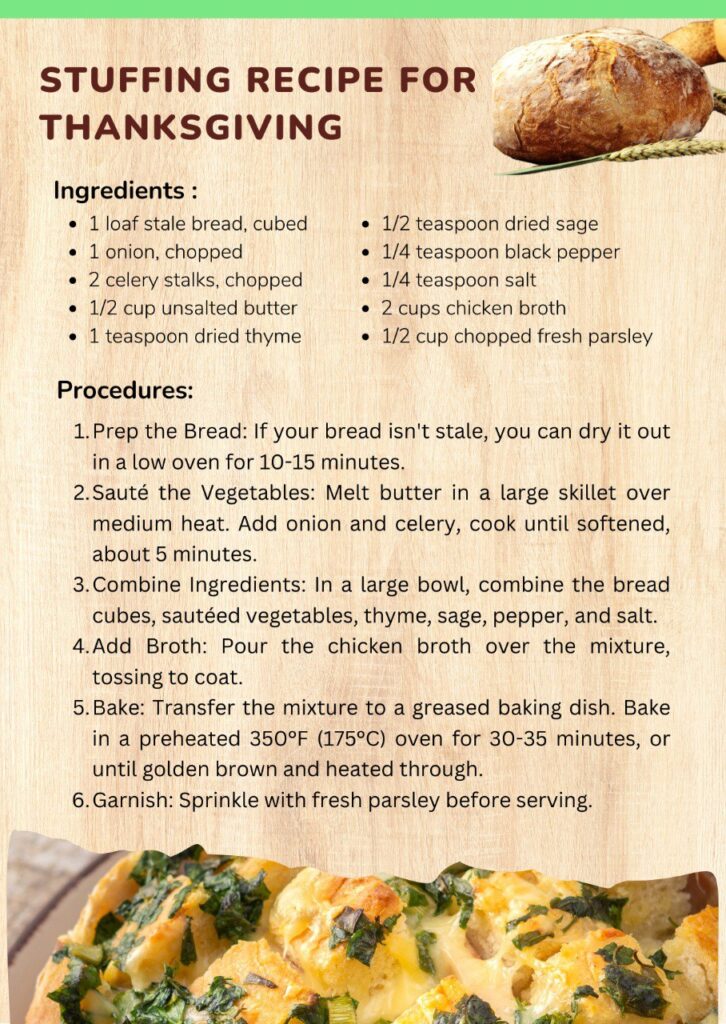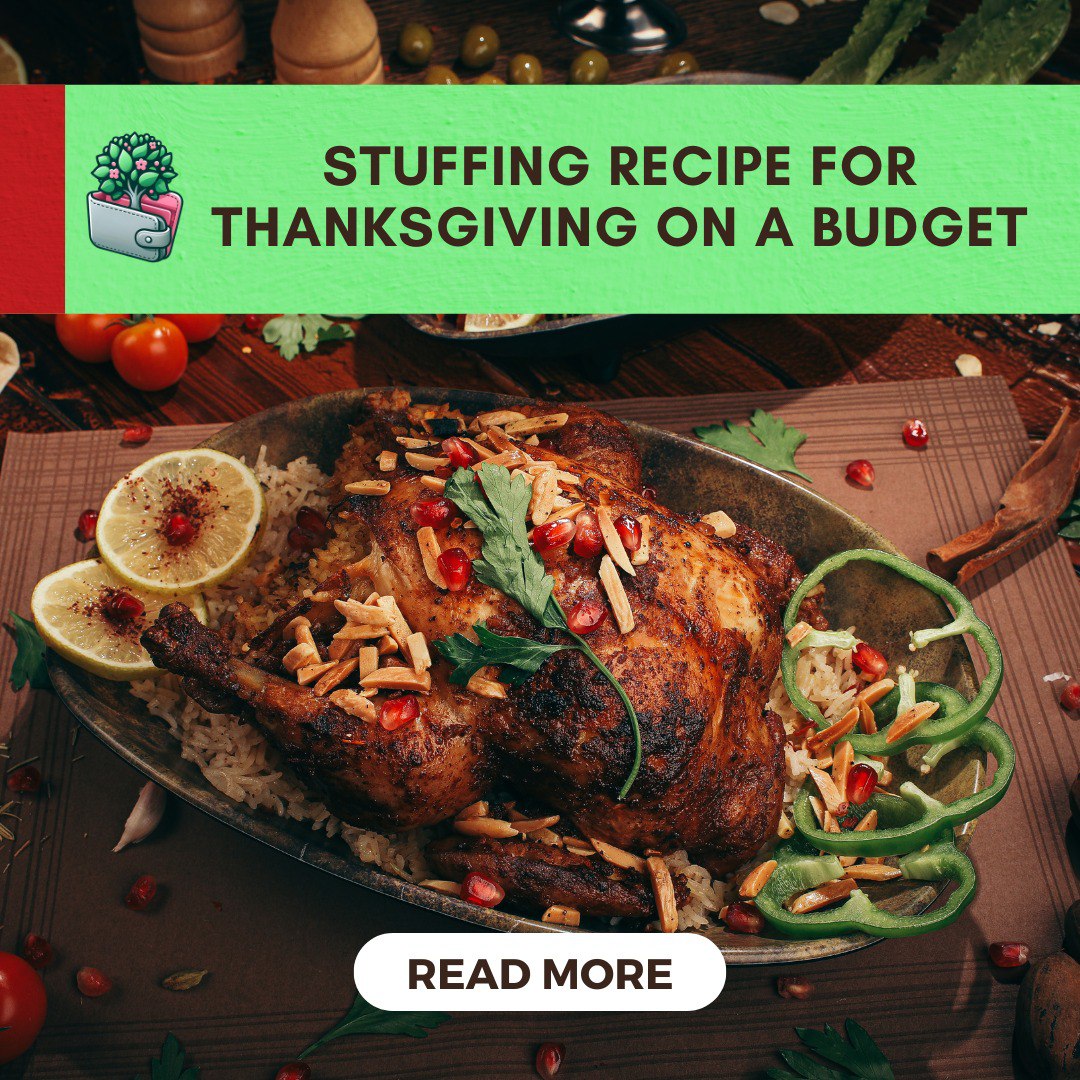Thanksgiving is a time for family, friends, and a whole lot of food. While it’s a time for indulgence, it’s also a time for smart spending. This classic stuffing recipe is not only delicious but also budget-friendly, making it the perfect addition to your holiday feast.
We’ll guide you through a simple, step-by-step process for stuffing recipe thanksgiving using affordable ingredients that you likely have on hand. From toasting bread to adding the perfect blend of herbs and spices, this recipe is easy to follow and delivers big flavors.
So, roll up your sleeves and get ready to create a Thanksgiving stuffing recipe that’s both satisfying and cost-effective. Let’s make this holiday season a memorable one, without breaking the bank.
What is Stuffing and How is it Different from Dressing?
When it comes to Thanksgiving dinner, stuffing, and dressing are two classic side dishes that often spark debate. While they may seem similar, there’s a key distinction between the two.
Stuffing is a mixture of ingredients, typically including bread cubes, vegetables (like celery, onions, and sometimes apples or cranberries), herbs, spices, and broth. This flavorful concoction is traditionally stuffed inside the cavity of a turkey or other poultry and cooked alongside it.
Dressing, on the other hand, is a similar mixture but is cooked separately from the poultry, usually in a baking dish or casserole. This method allows for more precise control over the cooking process and can result in a more evenly cooked and flavorful dish.
While the terms “stuffing” and “dressing” are often used interchangeably, the technical difference lies in their preparation method. So, the next time you sit down to a Thanksgiving feast, remember the distinction between these two delicious side dishes.
Essential Ingredients for a Delicious Stuffing Recipe Thanksgiving
A truly exceptional stuffing recipe thanksgiving hinges on a few key ingredients that work together to create a harmonious blend of flavors and textures. Here’s a breakdown of the essentials:
1. Stale Bread: The foundation of any great stuffing recipe thanksgiving is stale bread. Day-old or slightly stale bread absorbs the flavorful liquid ingredients without becoming soggy.
2. Fresh Herbs: A medley of fresh herbs, such as fresh parsley, fresh thyme, and rosemary, infuses the stuffing with a delightful aromatic quality.
3. Aromatic Vegetables: A classic combination of onions, celery, and garlic provides a savory base and adds depth of flavor.
4. Unsalted Butter: A touch of unsalted butter adds richness and moisture, enhancing the overall taste and texture.
5. Low-Sodium Chicken Broth: This liquid ingredient not only adds moisture but also imparts a savory, umami flavor.
6. Salt and Pepper: These essential seasonings balance the flavors and enhance the overall taste profile.
Optional Ingredients
Besides the typical core ingredients included in a stuffing recipe, consider adding these optional ingredients to elevate the flavor and texture:
- Sausage: A savory and flavorful addition that adds a hearty touch.
- Oysters: A classic choice that imparts a briny, luxurious flavor.
- Nuts: Chopped nuts like pecans or walnuts provide a crunchy texture and nutty flavor.
- Dried Fruit: Raisins, cranberries, or apricots add sweetness and a touch of tartness.
Dietary Considerations
In consideration of dietary considerations, here are some tips for creating inclusive stuffing recipes:
- Vegan: Use vegetable broth instead of chicken broth, and substitute butter with vegan butter or olive oil.
- Vegetarian: Omit any meat-based ingredients, such as sausage or oysters.
- Gluten-Free: Use gluten-free bread and ensure all other ingredients are gluten-free.
- Low-Carb: Use low-carb bread or alternative fillers like cauliflower rice or zucchini.
According to Kroger, “Thanksgiving is a chance to bring out our favorite family recipes, ones we’ve been looking forward to all year long. This makes planning and budgeting ahead simple. Create your menu in advance so that you can grab ingredients when they’re on sale. Shopping gradually will also help relieve some of the stress leading up to the holiday.”
Preparation
The type of bread you choose for your stuffing recipe thanksgiving can significantly impact its flavor and texture. Let’s explore the best bread options and preparation techniques.
Choosing the Right Toasting Bread for Your Stuffing Recipe Thanksgiving
The type of bread you choose can significantly impact the texture and flavor of your stuffing recipe thanksgiving. Here are some tips for selecting the perfect bread:
Classic Choices
French bread and Italian bread are popular choices for stuffing due to their firm texture and ability to hold up well to moisture.
Bread Preparation
Whether you prefer a uniform texture or a rustic look, you can either cube the bread or tear it into smaller pieces. Cubing ensures even cooking, while tearing creates a more rustic and uneven texture.
A Flavorful Twist
For a more nutritious and flavorful stuffing, consider using a combination of white and whole wheat bread. This blend offers a delightful contrast in texture and adds a wholesome touch to your dish.
According to Spend with Pennies, “The key to making this homemade stuffing recipe the right consistency is to ensure that the bread is really dry before adding broth. This allows it to soak up the broth (and flavor) without becoming soggy. If possible, purchase the bread a few days (or even weeks) early, tear it or cut it into cubes, and let it dry for a few days on the counter. Any kind of bread will do (like sourdough bread or half cornbread), I most often use a combination of brown and white.”
Building Flavor: Sautéing Aromatics
Sautéing onions, celery, and garlic is a crucial step in creating a flavorful stuffing recipe thanksgiving. This process softens the vegetables, releases their natural sugars, and infuses them with a rich, savory flavor. The aromatic compounds released during sautéing enhance the overall taste of the stuffing.
Combining Ingredients: A Perfect Blend
- Toast the Bread: Cube the bread and toast it in the oven until slightly crispy. This helps to absorb the flavorful liquid ingredients.
- Combine Wet and Dry Ingredients: In a large bowl, combine the toasted bread cubes, sautéed vegetables, herbs, and spices.
- Add Liquid: Gradually pour the broth or stock over the dry ingredients, tossing gently to coat.
- Adjust Flavor: Taste the mixture and adjust the seasoning as needed.
Cooking and Baking
- Oven Temperature and Time: Provide specific instructions for oven temperature and baking time.
- Monitoring Moisture Levels: Explain the importance of monitoring the moisture level and adding additional liquid if needed.
- Basting or Covering: Discuss the benefits of basting or covering the stuffing during baking.
- SEO Keyword Integration: Use keywords like “baking stuffing,” “cooking stuffing,” and “perfect stuffing” to optimize the section headings and content.
Tips and Tricks
Let’s delve into some tips and tricks to elevate your stuffing game and ensure a perfect dish every time.
Achieving the Ideal Texture:
Achieve the perfect stuffing texture by striking a balance between moisture and crispiness. Adjust the liquid amount based on bread freshness, opting for less liquid with stale bread. For a satisfying crunch, broil the stuffing or add a breadcrumb topping before baking.
Flavor Enhancement and Troubleshooting:
- Elevate the Flavor: Experiment with different herbs, spices, and add-ins like dried fruit, nuts, or sausage.
- Avoid Dryness: If your stuffing is too dry, add a bit more broth or stock.
- Prevent Sogginess: If your stuffing is too wet, bake it for a longer period or add more breadcrumbs.
- Make-Ahead Magic: Prepare the stuffing in advance and refrigerate or freeze it. Reheat it gently in the oven or microwave.
Cooking Your Stuffing Recipe Thanksgiving in a Casserole Dish or Baking Dish
Once you’ve assembled your flavorful stuffing after stirring occasionally, it’s time to transfer it to a baking dish and bake it to golden brown perfection. Here’s a step-by-step guide:
Choosing the Right Dish
– Classic Casserole Dish: A 9×13-inch casserole dish is a popular choice for baking stuffing recipe for thanksgiving. It offers ample space for the mixture to expand and cook evenly. You can also use a large skillet.
– Individual Ramekins: For a more elegant presentation, consider baking individual servings of stuffing in ramekins or small baking dishes. This allows for precise portion control and adds a touch of sophistication to your table.
Preparing the Dish
– Greasing the Dish: To prevent sticking and ensure easy removal, lightly grease the dish with butter or cooking spray. Alternatively, you can line the dish with parchment paper for easy cleanup.
Baking Time and Temperature
– Preheat Your Oven: Preheat your oven to 350°F (175°C).
– Baking Time: Transfer the stuffing mixture to the prepared dish and bake for 25-30 minutes, or until the top is golden brown and crispy. The exact baking time may vary depending on the size of your dish and the desired level of crispiness.
– Checking for Doneness: Insert a toothpick into the center of the stuffing. If it comes out clean, the stuffing is done.
How to Serve Stuffing
Traditionally, stuffing is served alongside a roasted turkey, mashed potatoes, and gravy. However, don’t limit yourself to the classics. Stuffing can also complement a variety of dishes, such as roasted vegetables, grilled meats, or even as a standalone side dish.
To elevate the presentation, consider plating the stuffing in a decorative dish and garnishing with fresh herbs. A sprinkle of chopped parsley or a sprig of rosemary can add a touch of elegance.
Cultural Variations and Historical Significance
Stuffing has a rich history and diverse regional variations. While the classic bread-based stuffing is a popular choice, consider exploring regional specialties like cornbread stuffing, which adds a sweet and savory flavor, or oyster stuffing, which offers a briny, luxurious taste. Understanding the historical significance of stuffing can add a cultural dimension to your Thanksgiving meal, making it a truly memorable experience.
Preparing Stuffing Recipe Thanksgiving in Advance
To streamline your preparations and ensure a stress-free holiday, consider prepping your classic stuffing Thanksgiving recipe in advance. Here are some tips:
1. Prep the Base: Prepare the bread mixture and aromatic vegetables (onions, celery, garlic) ahead of time in a large bowl. Store them separately in the refrigerator for up to 24 hours.
2. Assemble and Bake Fresh: While you can assemble the stuffing in advance, it’s best to cook it just before serving for the most optimal flavor and texture.
3. Individual Servings: For a convenient and elegant presentation, consider making individual servings of stuffing in ramekins or small baking dishes. This allows for easy portion control and adds a touch of sophistication to your table.
According to Yummly, “You don’t have to nix them all from your budget-friendly Thanksgiving menu, but if you’re hoping to save money, be prepared to change things up. If the food is prepared with intention and you’ve picked good recipes, no one will notice — or care about — your money-saving adjustments.”
Budget-Friendly Tips for Making Stuffing on a Budget
Creating a delicious stuffing recipe thanksgiving doesn’t have to break the bank. Here are some budget-friendly tips to help you save money without sacrificing flavor:
1. Utilize Stale Bread: Instead of throwing away stale or day-old bread, put it to good use in your stuffing recipe. Stale bread (dried bread cubes) absorbs moisture better, resulting in a flavorful and moist stuffing.
2. Bulk Buying and Planning: Purchase ingredients in bulk, especially those you use frequently, to reduce costs. Plan your meals in advance to minimize food waste and maximize your budget.
3. Homemade Broth: Consider making your own chicken stock, turkey stock, or vegetable broth using bones and scraps from previous meals. Homemade broth is often more flavorful and significantly cheaper than store-bought options.
4. Herb and Spice Powerhouse: Elevate your stuffing’s flavor profile with a variety of herbs and spices. These inexpensive seasonings can transform a simple dish into a culinary masterpiece.
5. Creative Ingredient Swaps: If a specific ingredient is out of your budget, explore creative substitutions. For example, dried cranberries can replace fresh ones, and vegetable broth can be used instead of chicken broth.
6. Grow Your Own Herbs: If you have a green thumb, consider growing your own herbs like rosemary, thyme, and sage. This can save you money in the long run and add a fresh, flavorful touch to your stuffing.
7. Shop Smart: Take advantage of seasonal produce and sales to save money on ingredients. Consider shopping at farmers’ markets or discount grocery stores for affordable produce and pantry staples.
8. Cook in Large Batches: If you have the freezer space, consider cooking a large batch of stuffing and freezing individual portions. This can save time and money on future meals.
9. Simplify Your Recipe: Don’t feel pressured to include every ingredient under the sun. A simple stuffing with a few key ingredients can be just as delicious as a more complex recipe.
10. Share with Friends and Neighbors: If you’re hosting a large Thanksgiving gathering, consider sharing the cost of ingredients with friends and neighbors. This can help reduce individual expenses and foster community spirit.
By implementing these budget-friendly tips, you can create a delicious and affordable stuffing recipe thanksgiving that will impress your guests without straining your wallet.
Not sure which method is right for you? Take our free quiz to find out!
Stuffing Recipe Thanksgiving

Ingredients:
- 1 loaf stale bread, cubed
- 1 onion, chopped
- 2 celery stalks, chopped
- 1/2 cup unsalted butter
- 1 teaspoon dried thyme
- 1/2 teaspoon dried sage
- 1/4 teaspoon black pepper
- 1/4 teaspoon salt
- 2 cups low-sodium chicken broth
- 1/2 cup chopped fresh parsley
Instructions:
- Prep the Bread: If your bread isn’t stale, you can dry it out in a low oven for 10-15 minutes.
- Sauté the Vegetables: Melt butter in a large skillet over medium heat. Add onion mixture and celery, cook until softened, about 5 minutes.
- Combine Ingredients: In a large bowl, combine the bread cubes, sautéed vegetables, thyme, sage, pepper, and salt.
- Add Broth: Pour the chicken broth over the mixture, tossing to coat.
- Bake: Transfer the mixture to a greased baking dish. Bake in a preheated 350°F (175°C) oven for 30-35 minutes, or until golden brown and heated through.
- Garnish: Sprinkle with fresh parsley before serving.
Tips:
- For a more flavorful stuffing, consider adding some chopped nuts, dried fruit, or fresh herbs like rosemary.
- If you want a crispier topping, you can broil the stuffing for a few minutes at the end of the baking time.
- To make your easy stuffing recipe ahead of time, prepare the bread and vegetable mixture, then store it in the refrigerator. When ready to bake, add the broth and bake as directed.
Common Questions and Answers About Stuffing Recipe Thanksgiving
Can I make stuffing ahead of time and freeze it?
Absolutely! In fact, making your stuffing ahead of time can be a great way to save time and reduce stress on Thanksgiving Day. To freeze your stuffing, prepare it as usual, then transfer it to an airtight freezer-safe container. Freeze for up to 3 months. When ready to use, thaw the stuffing in the refrigerator overnight, then reheat it in the oven until it’s hot and bubbly.
Can I use gluten-free bread for stuffing recipe Thanksgiving?
Yes, you can definitely use gluten-free bread for your stuffing. However, it’s important to note that gluten-free bread can have a different texture and flavor than traditional wheat bread. Be sure to choose a gluten-free bread that’s sturdy enough to hold up well in the stuffing. You may also need to adjust the cooking time slightly, as gluten-free bread can cook a bit faster.
Can I use a different type of liquid, like broth or wine, instead of chicken broth?
Absolutely! You can experiment with different liquids to add flavor and moisture to your stuffing. Vegetable broth, beef broth, or even wine can be great options. Just be mindful of the flavor profile you want to achieve and adjust the seasoning accordingly.
How can I make my stuffing extra crispy?
To achieve a crispy topping, you can try a few techniques. One method is to broil the stuffing for a few minutes towards the end of the cooking time. Another option is to add a layer of breadcrumbs or crushed crackers to the top of the stuffing before baking. You can use toasted bread cubes as well.
Can I add fruits or nuts to my stuffing?
Yes, adding fruits or nuts can add a delightful twist to your stuffing. Dried cranberries, apples, or pears are popular choices for fruits, while walnuts, pecans, or chestnuts can add a nutty crunch. Just be sure to adjust the cooking time if you add more moisture-rich ingredients.
How do I store leftover stuffing?
Leftover stuffing can be stored in an airtight container in the refrigerator for up to 3-4 days. To reheat in medium heat, place the stuffing in a baking dish and cover with foil. Reheat in a preheated oven at 350°F (175°C) until heated through.
A Flavorful Finale: The Perfect Stuffing for Your Thanksgiving Feast
With these tips and tricks, you’re well-equipped to create a stunning stuffing that will elevate your Thanksgiving dinner. Whether you prefer a classic, traditional stuffing or a more modern twist, the key to a delicious outcome lies in the careful selection of ingredients and the precise cooking technique. Consider your budget categories when choosing ingredients like herbs, spices, and bread.
Remember, the best stuffing recipe is one that reflects your personal taste and dietary needs. Feel free to experiment with different herbs, spices, and add-ins to create a truly unique dish. From hearty and comforting to light and refreshing, there’s a stuffing recipe out there for everyone.
Happy cooking, and happy Thanksgiving!


